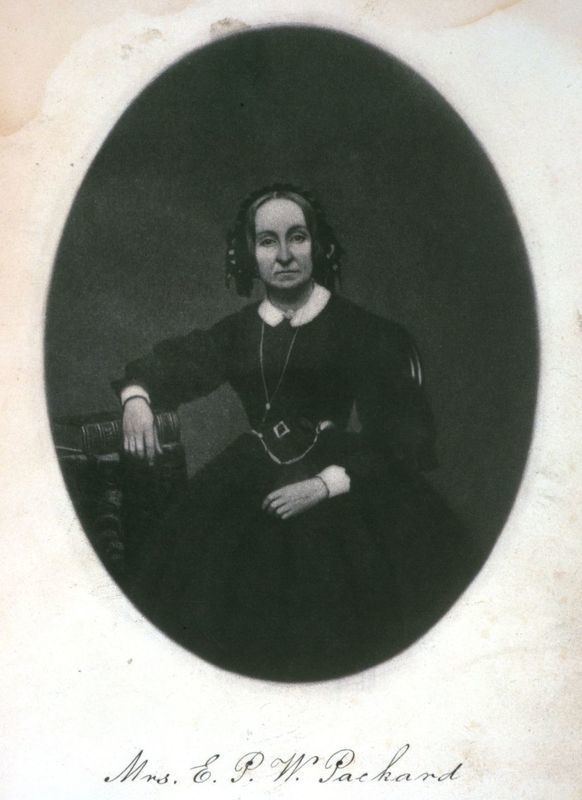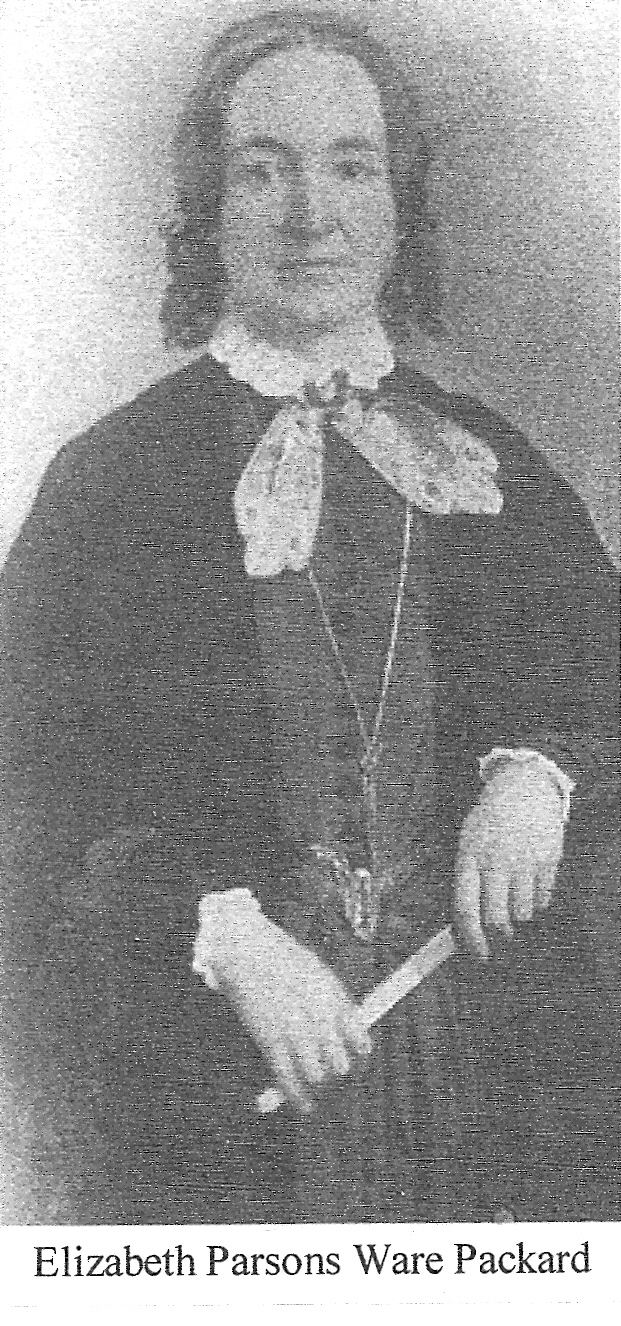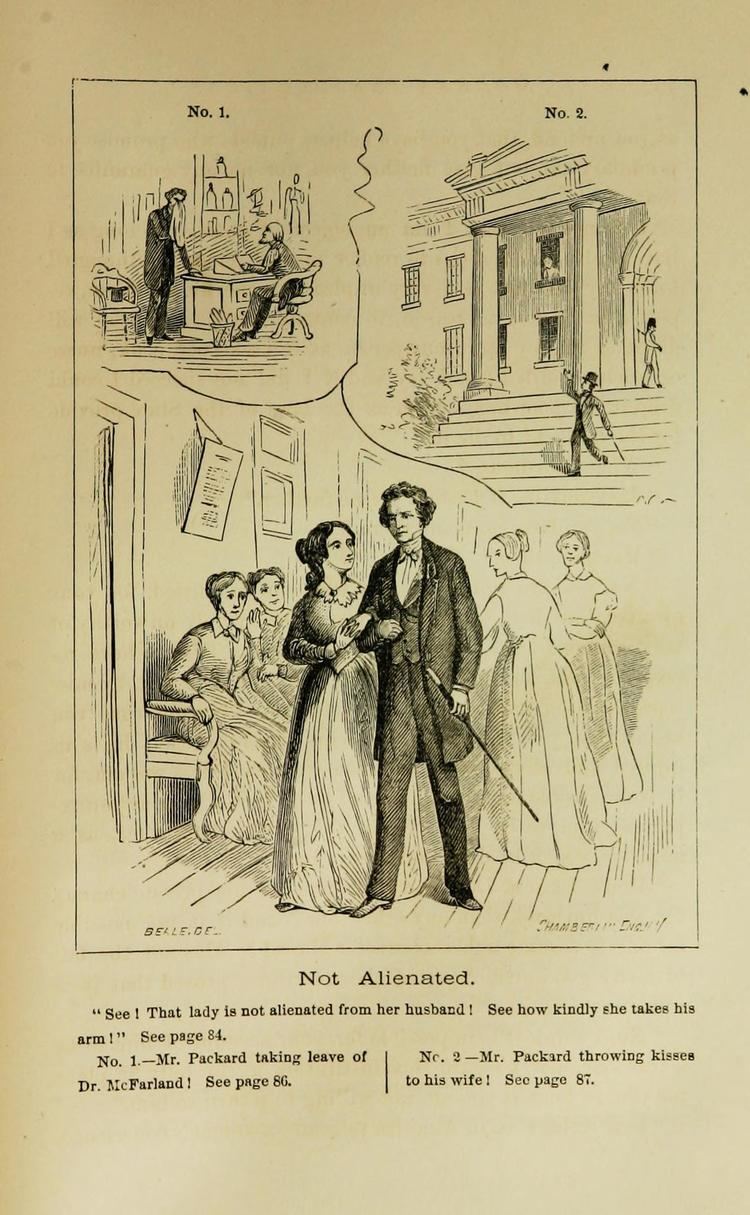Name Elizabeth Packard | ||
 | ||
Books The Prisoners' Hidden Li, Modern Persecution: Or Insane, Modern Persecution, Modern persecution - or - Insane, Marital Power Exemplifi | ||
Elizabeth packard
Elizabeth Parsons Ware Packard (28 December 1816 – 25 July 1897) was an advocate for the rights of women and people accused of insanity.
Contents

Life

Elizabeth Packard was the oldest of three children and the only daughter of Samuel and Lucy Ware. Samuel was a Congregational minister in the Connecticut Valley.

At the insistence of her parents, Elizabeth Parsons Ware married Calvinist minister Theophilus Packard, fourteen years her senior, on 21 May 1839. The couple had six children. The family resided in Kankakee County, Illinois and, for many years, appeared to have a peaceful marriage.
But Theophilus Packard held quite decisive religious beliefs. After many years of marriage, Elizabeth Packard outwardly questioned her husband's beliefs and began expressing opinions that were contrary to his. While the main subject of their dispute was religion, the couple also disagreed on child rearing, family finances, and the issue of slavery.
When Illinois opened its first hospital for the mentally ill in 1851, the state legislature passed a law that required a public hearing before a person could be committed against his or her will. There was one exception, however: a husband could have his wife committed without either a public hearing or her consent. In 1860, Theophilus Packard judged that his wife was "slightly insane", a condition he attributed to "excessive application of body and mind." He arranged for a doctor, J.W. Brown, to speak with her. The doctor pretended to be a sewing machine salesman. During their conversation, Elizabeth complained of her husband's domination and his accusations to others that she was insane. Dr Brown reported this conversation to Theophilus (along with the observation that Mrs Packard "exhibited a great dislike to me"). Theophilus decided to have Elizabeth committed. She learned of this decision on June 18, 1860, when the county sheriff arrived at the Packard home to take her into custody.
Elizabeth Packard spent the next three years at the Jacksonville Insane Asylum in Jacksonville, IL (now the Jacksonville Developmental Center). She was regularly questioned by her doctors but refused to agree that she was insane or to change her religious views. In 1863, in part due to pressure from her children who wished her released, the doctors declared that she was incurable and discharged her. Upon her discharge, Theophilus locked her in the nursery of their home and nailed the windows shut. Elizabeth managed to drop a letter complaining of this treatment out the window, which was delivered to her friend Sarah Haslett. Sarah Haslett in turn delivered the letter to Judge Charles Starr, who issued a writ of habeas corpus ordering Theophilus to bring Elizabeth to his chambers to discuss the matter. After being presented with Theophilus' evidence, Judge Starr scheduled a jury trial to allow a legal determination of Elizabeth's sanity to take place.
Packard v. Packard
At the subsequent trial of Packard v. Packard, Theophilus' lawyers produced witnesses from his family who testified that Elizabeth had argued with her husband and tried to withdraw from his congregation. These witnesses concurred with Theophilus that this was a sign of insanity. The record from the Illinois State Hospital stating that Mrs Packard's condition was incurable was also entered into the court record.
Elizabeth's lawyers, Stephen Moore and John W. Orr, responded by calling witnesses from the neighbourhood that knew the Packards but were not members of Theophilus' church. These witnesses testified they never saw Elizabeth exhibit any signs of insanity, while discussing religion or otherwise. The final witness was Dr. Duncanson, who was both a physician and a theologian. Dr. Duncanson had interviewed Elizabeth Packard and he testified that while not necessarily in agreement with all her religious beliefs..."I do not call people insane because they differ with me. I pronounce her a sane woman and wish we had a nation of such women."
The jury took only seven minutes to find in Elizabeth Packard's favor. She was legally declared sane, and Judge Charles Starr issued an order that she should not be confined.
Life after the trial
When Elizabeth Packard returned to the home she shared with her husband in Manteno, Illinois, she found that the night before her release, her husband had rented their home to another family, sold her furniture, and had taken her money, notes, wardrobe, and children and left the state. She appealed to both the Supreme Court of Chicago and Boston, where her husband had taken her children, but had no legal recourse, as married women in these states at the time had no legal rights to their property or children (see Coverture).
Elizabeth petitioned the Illinois and Massachusetts legislatures, and in 1869 legislation was passed allowing married women equal rights to property and custody of their children. Upon this being passed, her husband voluntarily ceded custody of their children back to Elizabeth, and her children came to live with her in Chicago.
While the Packards never formally divorced, they remained separated for the rest of their lives.
Elizabeth realized how narrow her legal victory had been. While she had escaped confinement, it was largely a measure of luck. The underlying social principles which had led to her confinement still existed. She founded the Anti-Insane Asylum Society and published several books, including Marital Power Exemplified, or Three Years Imprisonment for Religious Belief (1864), Great Disclosure of Spiritual Wickedness in High Places (1865), The Mystic Key or the Asylum Secret Unlocked (1866), and The Prisoners' Hidden Life, Or Insane Asylums Unveiled (1868). In 1867, the State of Illinois passed a "Bill for the Protection of Personal Liberty" which guaranteed all people accused of insanity, including wives, had the right to a public hearing. She also saw similar laws passed in three other states.
Literary uses
Barbara Hambly refers to Mrs. Packard in some detail in her novel on the insanity of Mary Todd Lincoln.
Emily Mann wrote a play on Mrs Packard, which premiered in May 2007. In Emily Mann's play, Mrs. Packard describes her life fully in the insane asylum; it is very historically accurate.
